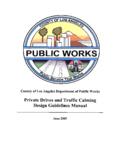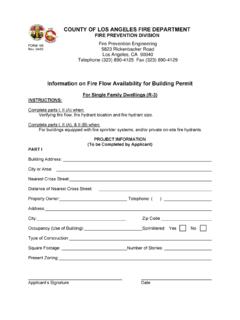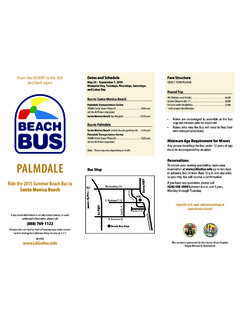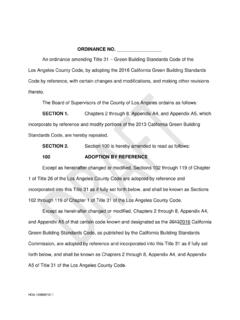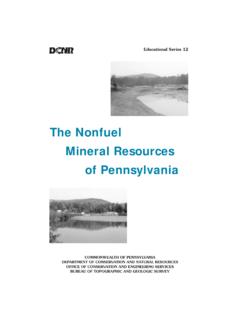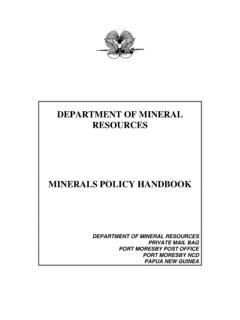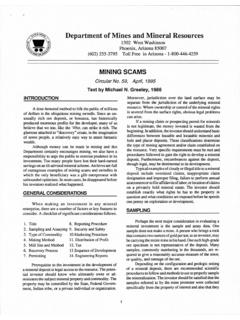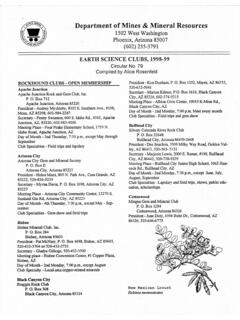Transcription of 3.8 Mineral vF - Los Angeles County Department of Public …
1 ICF International | Section | Mineral Resources Introduction This section describes the affected environment for Mineral resources, the regulatory setting associated with Mineral resources, the impacts on Mineral resources that would result from the project, and the mitigation measures that would reduce these impacts. Regulatory Setting Federal No federal regulations related to Mineral resources would be applicable to the proposed project. State Surface Mining and Reclamation Act of 1975 The State Mining and Reclamation Act of 1975 (SMARA) requires that the State Mining and Geology Board (SMGB) map areas throughout the State of California that contain regionally significant Mineral resources. Aggregate Mineral resources within the state are classified by the SMGB through application of the Mineral resource Zone (MRZ) system.
2 The MRZ system is used to map all Mineral commodities within identified jurisdictional boundaries. The MRZ system classifies lands that contain Mineral deposits and identifies the presence or absence of substantial sand and gravel deposits and crushed rock source areas ( , commodities used as, or in the production of, construction materials). The State Geologist classifies MRZs within a region based on the following factors: z MRZ-1: Areas where adequate information indicates that no significant Mineral deposits are present, or where it is judged that little likelihood exists for their presence. z MRZ-2: Areas where adequate information indicates that significant Mineral deposits are present, or where it is judged that a high likelihood exists for their presence. z MRZ-3: Areas containing Mineral deposits for which the significance cannot be determined from available data.
3 Z MRZ-4: Areas where available information is inadequate for assignment of any other MRZ category. Mining operations and mine reclamation activities are required to be performed in accordance with laws and regulations adopted by the SMGB. The State Department of Conservation s Office of Mine Reclamation (OMR) oversees reclamation requirements. County of Los Angeles | Bicycle Master Plan Draft PEIR | Mineral Resources ICF International | Division of Oil, Gas, and Geothermal Resources The California State Department of Conservation maintains the Division of Oil, Gas, and Geothermal Resources (DOGGR). The DOGGR is responsible for monitoring the drilling, operation, maintenance, and abandonment of oil, gas, and geothermal wells with the intention of environmental protection, Public health and safety, and general environmental conservation methods.
4 The DOGGR is also responsible for collecting groundwater, oil, gas, and geothermal resource data for maintaining a record of all drilled and abandoned well locations. Division of Mines and Geology The California Division of Mines and Geology (DMG) operates within the Department of Conservation. The DMG is responsible for assisting in the utilization of Mineral deposits and the identification of geological hazards. Local Los Angeles County General Plan General Goals TheCounty of Los Angeles General Plan ( County of Los Angeles 1980a) contains several general goals and policies. These general goals express the purpose of all elements of the general plan and are intended to be used as a guide for implementation. One of the general goals applicable to the proposed project and Mineral resources is listed below: z Conserve resources and protect the environment.
5 Conservation and Open Space Element The Conservation and Open Space Element of the County of Los Angeles General Plan sets policy direction for open space resources in the County . These resources include Mineral production. The element s policies are based on the need to conserve natural amenities, protect against natural hazards, and meet the Public s desire for open space experiences. Objectives The conservation and open space element includes the following objectives to implement its stated policies: z Support local efforts to improve air quality. z Conserve energy resources and develop alternative energy sources. z Conserve water and protect water quality. z Preserve and protect prime agricultural lands, forests, fisheries, significant ecological areas, and other biotic resources. z Protect Mineral resources. County of Los Angeles | Bicycle Master Plan Draft PEIR | Mineral Resources ICF International | z Preserve and protect sites of historical, archaeological, scenic, and scientific value.
6 Z Reduce the risk to life and property from seismic occurrences, flooding, erosion, wildland fires, and landslides. z Improve opportunities for a variety of outdoor recreational experiences. Needs and Policies Policy 15 of the conservation and open space element states the following: z Protect and conserve existing Mineral resources, evaluate the extent and value of additional deposits, and require future reclamation of depleted sites. Environmental Setting This section discusses the existing conditions related to Mineral resources in the study area. According to the County of Los Angeles General Plan, major local Mineral resources consist of oil, rock deposits, and sand and gravel. California is the largest producer of sand and gravel in the nation and the greater Los Angeles area is the nation s leading producer for its geographical size.
7 The County has high quantities of sand and gravel, which are located close to the market. Major sand and gravel extraction sites are located in the alluvial fans of the Big Tujunga Wash in the San Fernando Valley and in the San Gabriel River near Irwindale. Other extraction areas are located in northern Los Angeles County in other washes. ( County of Los Angeles 1980a.) Several areas identified as MRZ-2 are located in the project vicinity. These areas are located east and north of downtown Los Angeles , near the City of Burbank and in the Santa Clarita Valley and Antelope Valley areas. Other areas within the project area identified as MRZ-2 are near La Canada Flintridge and the City of San Marino. The El Monte, Covina, and Azusa areas also contain areas identified as MRZ-2. There are also several oil fields located within the vicinity of the project (California Department of Conservation 2001, 2003).
8 Project Impacts and Mitigation Measures This section describes the impact analysis relating to Mineral resources for the Bicycle Master Plan at the program level. It describes the methods used to determine the impacts of the project and lists the thresholds used to conclude whether an impact would be significant. Measures to mitigate ( , avoid, minimize, rectify, reduce, eliminate, or compensate for) significant impacts accompany each impact discussion, if necessary. Detailed analysis at the project level will determine the significance of impacts for individual Bicycle Master Plan projects and, if necessary, the applicability of mitigation measures. Methods This section was prepared using a qualitative analysis that included the following steps in order to document existing conditions: 1) review the Bicycle Master Plan and other existing County planning County of Los Angeles | Bicycle Master Plan Draft PEIR | Mineral Resources ICF International | documents to document existing Mineral resources conditions of the project area; and 2) review state-maintained maps to identify areas containing Mineral resources.
9 In order to assess potential impacts of the proposed bikeways, their alignments were reviewed to identify where Mineral resources and/or oil drilling occur. Thresholds of Significance For this analysis, an impact pertaining to Mineral resources was considered significant if it would result in a yes answer to any of the following questions from the Los Angeles County Initial Study Checklist. z Would the project result in the loss of availability of a known Mineral resource that would be of value to the region and the residents of the state? z Would the project result in the loss of availability of a locally important Mineral resource discovery site delineated on a local general plan, specific plan, or other land use plan? Impacts and Mitigation Measures Impact : Result in the loss of availability of a known Mineral resource that would be of value to the region and the residents of the state.
10 As discussed in Section , the project area contains areas of gas and oil reserves and areas identified as MRZ-2, which are zones that include known Mineral deposits or where there is a high likelihood for their presence. Construction Impacts related to loss of availability of known Mineral resources would be permanent. See discussion under Operation, below. Operation Depending on the nature and extent of extraction activity, operation of the bikeways included in the Bicycle Master Plan may result in the disruption or removal of existing extraction operations or may preclude the future extraction of resources due to the location of bikeways on known Mineral resource areas. The bikeway network could result in a traffic or access conflicts with extraction of Mineral resources of regional or statewide importance. This would be a significant impact.
